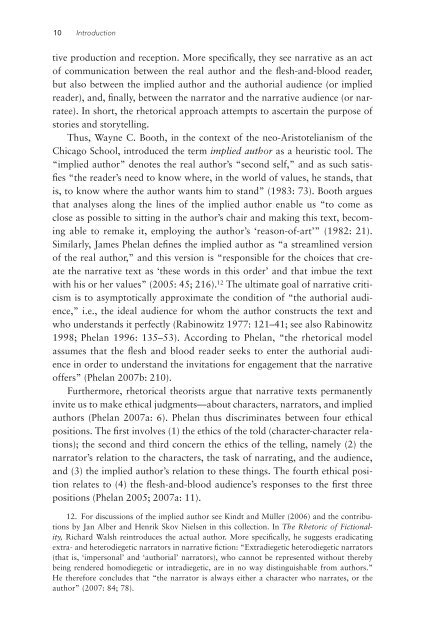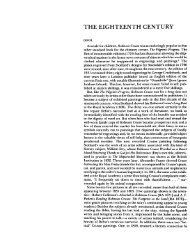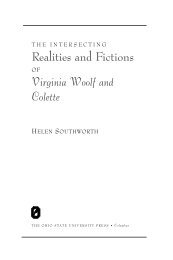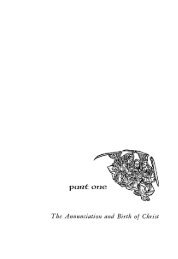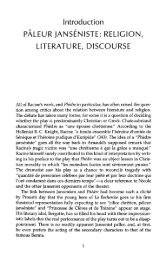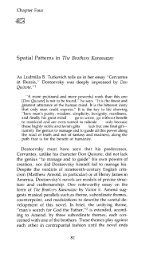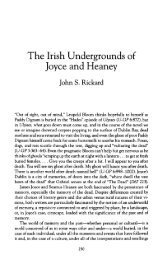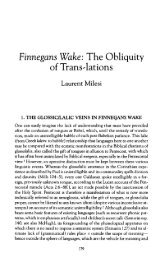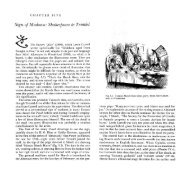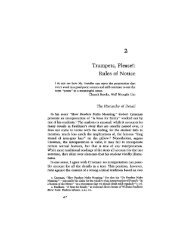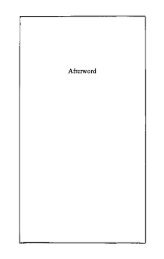Postclassical Narratology: Approaches and Analyses
Postclassical Narratology: Approaches and Analyses
Postclassical Narratology: Approaches and Analyses
Create successful ePaper yourself
Turn your PDF publications into a flip-book with our unique Google optimized e-Paper software.
10 Introduction<br />
tive production <strong>and</strong> reception. More specifically, they see narrative as an act<br />
of communication between the real author <strong>and</strong> the flesh-<strong>and</strong>-blood reader,<br />
but also between the implied author <strong>and</strong> the authorial audience (or implied<br />
reader), <strong>and</strong>, finally, between the narrator <strong>and</strong> the narrative audience (or narratee).<br />
In short, the rhetorical approach attempts to ascertain the purpose of<br />
stories <strong>and</strong> storytelling.<br />
Thus, Wayne C. Booth, in the context of the neo-Aristotelianism of the<br />
Chicago School, introduced the term implied author as a heuristic tool. The<br />
“implied author” denotes the real author’s “second self,” <strong>and</strong> as such satisfies<br />
“the reader’s need to know where, in the world of values, he st<strong>and</strong>s, that<br />
is, to know where the author wants him to st<strong>and</strong>” (1983: 73). Booth argues<br />
that analyses along the lines of the implied author enable us “to come as<br />
close as possible to sitting in the author’s chair <strong>and</strong> making this text, becoming<br />
able to remake it, employing the author’s ‘reason-of-art’” (1982: 21).<br />
Similarly, James Phelan defines the implied author as “a streamlined version<br />
of the real author,” <strong>and</strong> this version is “responsible for the choices that create<br />
the narrative text as ‘these words in this order’ <strong>and</strong> that imbue the text<br />
with his or her values” (2005: 45; 216). 12 The ultimate goal of narrative criticism<br />
is to asymptotically approximate the condition of “the authorial audience,”<br />
i.e., the ideal audience for whom the author constructs the text <strong>and</strong><br />
who underst<strong>and</strong>s it perfectly (Rabinowitz 1977: 121–41; see also Rabinowitz<br />
1998; Phelan 1996: 135–53). According to Phelan, “the rhetorical model<br />
assumes that the flesh <strong>and</strong> blood reader seeks to enter the authorial audience<br />
in order to underst<strong>and</strong> the invitations for engagement that the narrative<br />
offers” (Phelan 2007b: 210).<br />
Furthermore, rhetorical theorists argue that narrative texts permanently<br />
invite us to make ethical judgments—about characters, narrators, <strong>and</strong> implied<br />
authors (Phelan 2007a: 6). Phelan thus discriminates between four ethical<br />
positions. The first involves (1) the ethics of the told (character-character relations);<br />
the second <strong>and</strong> third concern the ethics of the telling, namely (2) the<br />
narrator’s relation to the characters, the task of narrating, <strong>and</strong> the audience,<br />
<strong>and</strong> (3) the implied author’s relation to these things. The fourth ethical position<br />
relates to (4) the flesh-<strong>and</strong>-blood audience’s responses to the first three<br />
positions (Phelan 2005; 2007a: 11).<br />
12. For discussions of the implied author see Kindt <strong>and</strong> Müller (2006) <strong>and</strong> the contributions<br />
by Jan Alber <strong>and</strong> Henrik Skov Nielsen in this collection. In The Rhetoric of Fictionality,<br />
Richard Walsh reintroduces the actual author. More specifically, he suggests eradicating<br />
extra- <strong>and</strong> heterodiegetic narrators in narrative fiction: “Extradiegetic heterodiegetic narrators<br />
(that is, ‘impersonal’ <strong>and</strong> ‘authorial’ narrators), who cannot be represented without thereby<br />
being rendered homodiegetic or intradiegetic, are in no way distinguishable from authors.”<br />
He therefore concludes that “the narrator is always either a character who narrates, or the<br />
author” (2007: 84; 78).


